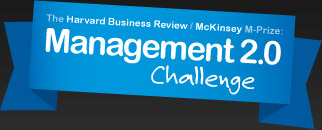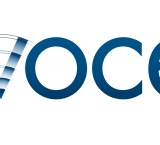Meet the Winners
We’re thrilled to introduce you to the winners of the Management 2.0 Challenge—the first phase of the HBR/McKinsey M-Prize for Management Innovation.
Story:
My Customer: One Voice is Noise, Many is a Chorus – Voice of the Customer through the Employee
"My Customer" is the platform Best Buy created to unleash and amplify the powerful voice of its 100,000+ frontline employees to share what they heard or learned from daily interactions with customers. Best Buy thrives from the power of its people and is core to its philosophy and success. Voice of the Customer through the Employee (VOCE) is what put this philosophy to action and has driven proven results.
Best Buy is an innovative Fortune 100 $50 billion consumer electronics retailer with over 1500 retail locations across North America, Europe and Asia. It was founded in 1966 and is headquartered in Minneapolis, MN. The Company prides itself on the knowledge of its employees and unleashing the power of its people as part of its core philosophy and values to help drive innovation and change to maintain its leading edge in the industry.
Once upon a time there was an employee. This employee had many insights to share and represented hundreds of other employees who felt the same way. They knew that if someone listened, many problems would be solved and opportunities would be pursued. They wanted to UNLEASH, but did not know how. Then came “My Customer.” And they shared insights because they cared. They cared about their customer’s experience and their leadership took notice. And the rest is history.
Best Buy’s employees engage in over a billion customer interactions annually. The opportunity presented itself to provide an avenue for powerful insights and intellectual knowledge to be shared that our employees encompass on a daily basis on behalf of our customers.
The thought was that Best Buy could solve real problems that employees escalated on behalf of our customers in as close to real-time as possible. By identifying spikes in the analytics, it would serve as early indicators of potentially bigger opportunities or issues that could be addressed by the various business units throughout the company from a simple aggregation of field intelligence from passionate employees who are committed to improving the customer experience.
Another trigger was the real need for retail leadership to have increased transparency of employee and customer opportunities to manage their local markets in an effort to support employee autonomy. Past efforts have been unsuccessful due to the lack of transparency in which employees did not have visibility to what was being done with their feedback. As a result, an ongoing feedback loop with retail leadership has been established and there is a dedicated team to funnel the insights to the right teams.
The My Customer tool is the software platform in which employees have the opportunity share all that they know about their customers by providing insights in a real-time fashion that helps create transparency with their leadership and Corporate.
The secret to maintaining engagement is twofold: 1. Employees have a feedback loop mechanism in which a dedicated team funnels insights to the correct teams and decision-makers and 2. Employees’ immediate managers recognize great submissions from their teams and use My Customer as a way to drive employee engagement and satisfaction. This “secret” is what has now led to over 6,000 weekly submissions of insights in a year timeframe!
A year ago, a concept was born. When Voice of the Customer through the Employee was in its pilot stage, a specific district was empowered to drive changes based on what insights their employees provided on a daily basis. Changes that would typically take months to implement from Corporate were implemented in a matter of days at the local retail level.
Case in point #1: The pilot district noticed that customers were leaving the stores due to not carrying Apple products. When the store leadership realized the amount of employee insights on this subject, they created a strategy to address and approach these customers when asking for Apple. As a result, the store was able to convert many of these Apple-seeking customers to PCs after realizing that many of the key features and benefits were available in most PCs. Revenue within that district increased 10% within 30 days as a result of the strategy.
Case in point #2: There was customer confusion in delineating between the Geek Squad and Returns counter, which was voiced by numerous employees. Signage was implemented as a result to better distinguish the two, and as a result, customer satisfaction scores increased dramatically by 340 basis points.
At the Corporate level, the presentation of the aggregate themes and trends that surfaced from thousands of employee insights instigated abrupt activation and change on many different topics. Weekly and monthly reporting was established to promote the following:
- Transparency of key themes and topics from employees
- Immediacy to address important issues from store employees
- Visibility at all levels in the organization regardless of hierarchy
A pivotal point in the reporting of these insights is that it was no longer a sample size of a few employees stating the same issue. Hundreds of powerful voices joining forces helped create a movement in how changes needed to happen and validation of key issues. Even more critical is that key decision-makers were listening. It did not matter what your rank was in the field or your title. The fact that any employee could participate in helping to drive change was powerful in itself and leaders were and still are listening, and it is now ingrained in normal business rhythms less than a year later.
First and foremost was responding to cynicism that this would fail. It has been done before. Employees would eventually lose interest. It was a “flavor of the month,” and the organization would not listen. Were they ever wrong.
Challenge #1 – This would fail.
Solution – Create an ongoing feedback loop with the field and corporate. Over-communication was key. A weekly and monthly rhythm was established with a wide audience of key corporate stakeholders ensuring transparency. Moreover, having the courage to share what was learned on behalf of thousands of employees and staying undeniably committed to amplifying their important voice was critical. Ongoing persistence in understanding what was being done with the insights was and continues to be equally as critical so that our employees know that something was being done with what was shared.
Challenge #2 – This was done before.
Solution – Implement what was learned previously to make this a world-class program. The failure was a part of the journey, but it did not stop the team for the relentless pursuit of improvement and ongoing commitment to our employees. Let employees know that something is being done with the insights. Keep corporate partners apprised of any new trends or themes in the data and over-communicate and share.
Challenge #3 – Employees would lose interest.
Solution – Again, over-communicate what was heard, what was learned, and what is being done. Retail partners were also taught best practices to maintain engagement by keeping local leaders engaged. If local leaders read the insights, then they can recognize their employees for the insights shared. Following the simple philosophy that if my leader acknowledges and recognizes me for what I contributed, then I will continue to share what I know about my customer. Employees will stay engaged when they know their leader cares about them and values their insight and perspective no matter what the industry or role.
Previous to VOCE, there was not a unified method to cohesively collect hundreds of employee insights on any key topic. The Company had a solid foundation for implementing change based on customer insights and financials, but there was never an integrated frame inclusive of the employee perspective. If anything, there was anecdotal feedback from usually sample size of less than 10 employees on any given issue.
VOCE has been woven into the fabric of customer insights as a way to further validate and provide a unique perspective on the customer experience that allows leadership to make better informed decisions to benefit our customers and shareholders. Measurement is based on the number of employee submissions, customer satisfaction, and financial outcomes.
An example to articulate this is over the past holiday campaign, leadership needed to obtain a better sense of how to increase store traffic and if resources should be allocated to making the Best Buy Mobile offering of “Free Phone Friday” a daily event. As a Consumer Insights Unit, an integrated approach between customers, competition, financials and now employees was implemented to inform the actionable insight that “Free Phone Friday” should be a daily offering. Employees clearly stated the positive sentiment that was exuded among customers over the offering and validated that it has helped increase traffic at the local level. This type of decision in the past would have taken months to make to the equivalent of moving mountains, but the real-time insights helped inform the decision in less than one month!
Another key example was with the implementation of the Buy Back program at Best Buy. The business problem was to obtain a clear understanding of the product categories that customers requested Buy Back, as it was limited to certain products. Hundreds of employees offered unprompted insights that the program needed to expand to gaming, GPS, MP3 devices, Blu-ray players and desktop computers. This was further validated by customer surveys resulting in the expansion of the program (less than four months after the initial launch)!
Unintended side (positive) effects – As a result of being part of an insights unit in which VOCE resides, the field intelligence shared through the My Customer software platform has enabled such rich insights that typical primary research firms charge thousands of dollars for. The aggregate of such insights have proven to be cost-effective for the enterprise and fast and flexible in a high-speed and dynamic retail environment that needs constant input and insights to drive the business forward.
Another side effect was the fact that employee satisfaction directionally increased in correlation with the submissions provided. Simply put, if leaders listen to what employees share, employees in turn feel good about their work and feel valued. This also was a proven differentiator in the industry and unique to the Best Buy culture for employees to feel empowered to share what they know about their customers and offer solutions, whereas many key competitors take a top-down approach. This was critical component for employees feeling valued as trusted resources as having answers to common problems.
Key Guiding Principles:
- Keep it SIMPLE – All employees, regardless of industry, have insights to share, but are time-constrained. As long as the platform is simple and fast, employees will participate. Enable them to UNLEASH.
- Over-Communicate – To all employees, regardless of title, role, hierarchy. It’s all about creating transparency for the benefit to the enterprise. Have the courage to share because everyone cares.
- Recognize – A simple “thank-you” goes a long way when employees are acknowledged for what they share. They just want to be heard and feel valued. Recognition = Engagement. Engagement = Happy Customers. Happy Customers = Bottom-Line Results.
This submission was co-authored by Danielle Snook and Anastasia Maier.
Steve- awesome story. Having experience on both the front lines and at corporate HQ, I'm acutely aware of the communication gap. I've often thought of how to bridge that gap, while separating the meaningful, actionable insights from the noise. It seems that you're well on the way to solving that problem. Even beyond an operational/marketing capability, VOCE reinforces a core BBY value- unleashing the power of the people. This is how cultures are built and maintained; meaningful stories entering the folklore of the company's history. It was a pleasure to have had the chance to speak with you this past summer.
-Peter
- Log in to post comments
Well stated and I especially liked the notion to create far more transparency. Would you agree that to do this would be also to look at the diversity at the top - that ensures diverse voices get included in the solutions? Well stated possibilities - if more talent gets facilitated in intelligence-fair ways.
It's been my experience that when diverse exchanges happen at the top - diversity begins to enrich the entire process, throughout. That too impacts employees feeling valued and tossing new talents into the ring in ways that offer hope for change that's far more radical than any repackaging efforts that appear to stoke change while remaining in ruts. Thanks for tsharing and I'd welcome your thoughts.
- Log in to post comments
Hi Steve,
great story. I just love this part " Recognition = Engagement. Engagement = Happy Customers. Happy Customers = Bottom-Line Results" because I have something quite like this in my story (Idea Market).
Good luck.
MP
- Log in to post comments
I think this is both a simple and effective initiative with concrete results BUT I was wondering how you manage the analyses. Given the size of Best Buy, there should be lots of feedback that need to be classified, read, tagged etc. For example among all the comments received from 100000+ frontline employees (I know not all of them are supposed to send feedback but even a 1% participation would mean a lot) several may be dealing with the same issue. How do you deal with that redundancy? Reading all comments one by one would be an extremely time consuming effort!
- Log in to post comments
Let me show my cards--I'm a strong advocate of collective intelligence (CI) and crowd sourcing, whic I take to be two genre of the wisdom of crowds' approach to making estimates and predictions, finding patterns, gaining insights, finding, multiplying, and applying expertise--in short ways to aggregate individual perspectives on a common matter of interest from a diverse, distributed, and independent population into intelligence which is better than that held by any individual in a group and invariably even by the smartest person in the group.
CI has, I believe, wide application in several aspects of retailing. The uses to which Best Buy has applied VOCE demonstrate some important ones--operations, customer service, store configuration, and clarity in positioning and differentiating--that is defining and communicating the value of a retailer's offer.
Store associates are a well spring of information--distilled from the sum of their individual interactions with customers. The depth and relevance of their information is directly proportional to their tenure as an associate, the domain knowledge they bring to their roles from their personal lives (technophiles here), and the quality of their interactions with customers (here gained through Best Buy's associates' customer interaction model--assisted selling of complex products often woven into solutions).
VOCE leverages all of this and adds a virtuous loop which connects customers and associates with decision-making and closes the loop with recognition and visible results.
Retailer of all stripes can and should learn from Best Buy's VOCE program. This model can be applied to merchandising and product development and extended in this regard to include customers and consumers. As I posed in a blog, in fashion retailing, it's the sidewalk, not the catwalk that sets trends. CI is ably adept at catching consumer-driven trends.
- Log in to post comments
The value of gathering customer insight is absolutely immeasurable. The challenge as a company expands- especially with as many touches as Best Buy is not just gathering and compiling the data, but enabling the data to be used in a meaningful way. By focusing the high leverage points in alignment with both line level employee and customer insight, this seems like an ambitious project with high ideals, yet manageable, lofty goals. My hat is off, as this seems to the only thing that will truly differentiate the customer experience in the valuable middle market.
- Log in to post comments
A great program at Best Buy that for me hits the three "E's".....efficiency, effectiveness and engagement.
Efficiency - creates the capability to transfer a significant amount of traditional consumer research spending to utilizing the feedback and insights of your sales force....also significantly reduces traditional research fielding time
Effectiveness - creates the capability to generate REAL WORLD and TRANSPARENT insights from those closest to the end-customer.....the sales associates.....in the environment that these customers are operating within...to me, it brings the old P&G "moment of truth" model to life, and thus generates many more actionable insights than traditional "conceptual" research models
Engagement - what a wonderful capability to have 150,000++ employees engage in the customer-centric operating model that Best Buy is continuing to build; these employees have an easy-to-use mechanism and ultimately "skin in the game" of achieving growth through putting customer insights at the center of Best Buy's business model; one of the best co-creation stories leveraging today's virtual technology that I have seen.
- Log in to post comments














You need to register in order to submit a comment.